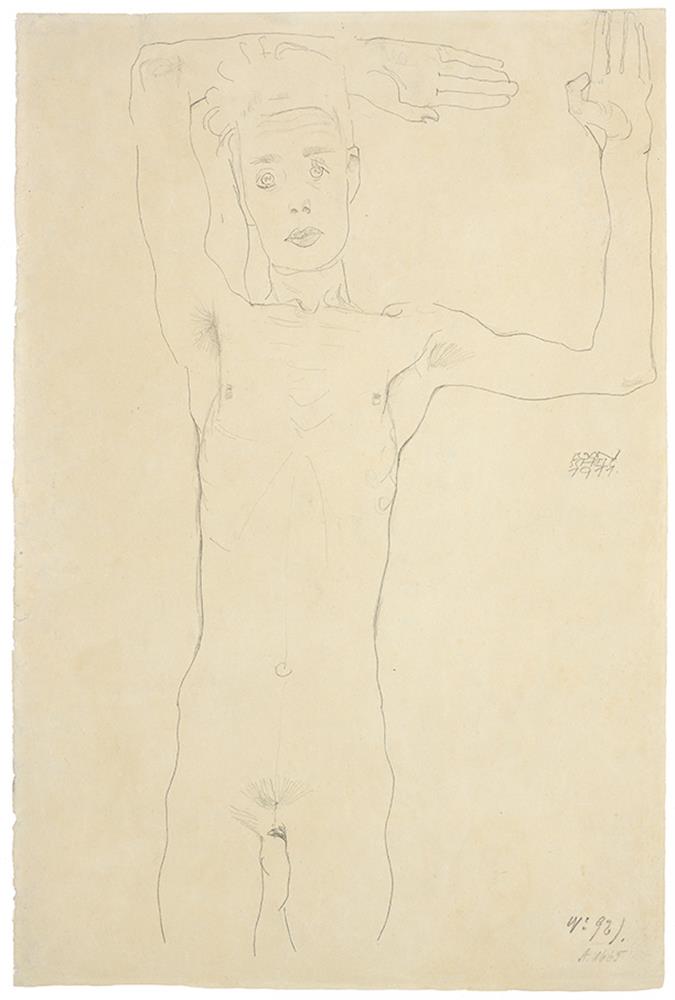
Tulln 1890 - 1918 Vienna
Standing Male Nude with Raised Arms (Self-Portrait)
Pencil drawing „Baumstudie“ (Study of Trees, Kallir WV no 1202) on the reversePencil on paper
47.6 x 31.8 cm
Signed and dated centre right: EGON/ SCHIELE/ 1911
Inscribed at lower right by another hand: No 92 A.1665
Kallir WV no 957
Provenienz:
Galerie St. Etienne, New York
Bayard Storey
Sotheby‘s Parke-Bernet, New York
Estate of Serge Sabarsky, New York
Vally Sabarsky Trust, New York
Galerie St Etienne, New York, as an agent for the above
Swiss private collection
Ausstellungen:
Galerie St. Etienne, New York 1965
Ilse Schweinsteiger Gallery, Munich 1976
Westdeutscher Kunstmarkt, Düsseldorf 1976
Würthle Gallery, Vienna 1977
Welz Gallery, Salzburg 1977
Westdeutscher Kunstmarkt, Cologne 1977
Seibu Museum of Art, Tokyo 1979
Marlborough Fine Art, London 1979
Historical Museum of the City of Vienna, Vienna 1981
Neue Galerie der Stadt Linz/Wolfgang-Gurlitt-Museum, Linz 1982
Museum Villa Stuck, Munich 1982
Kestner-Gesellschaft, Hannover 1982
Salle Saint-Jean, Hôtel de Ville, Paris 1984
Pfalzgalerie, Kaiserslautern 1984
Museo Civico, Bolzano 1984
Palazzo Reale, Turin 1985
Galerie Hauser & Wirth, Zurich 1994
National Gallery of Iceland, Reykjavik 1996
Literatur:
Serge Sabarsky, Egon Schiele. Disegni Erotici, Milan 1981, ill. front cover
Exhibition catalogue „Egon Schiele. Zeichnungen und Aquarelle“,
Historical Museum of the City of Vienna, Vienna 1981, ill. p. 52, no 45
Jane Kallir, Egon Schiele: The Complete Works. Expanded edition, New York 1998, ill. p. 456, WN no 957, p. 487, WV no 1202 (study of trees on the reverse)
"Standing Male Nude with Raised Arms" belongs to a series of self-portraits drawn by Schiele in late 1911 and early 1912 (see also Kallir D. 956 and 1160-1163). As was typical of his work during this period, the artist used a very hard pencil for all these self-portraits (with the exception of Kallir D. 1160, executed in ink). Possibly Schiele’s choice of medium was influenced by his mentor, Gustav Klimt. In the work of both artists, hard pencil creates a very fine, delicate line – in Schiele’s case, a line more delicate than is seen in work from other periods. Viewed as a group, these 1911-12 self-portraits convey a variety of distinct personalities. Schiele was experimenting with different personae – in part to explore his own identity, and in part to map correlations between outward appearance and inner emotional states.
In late 1911, Schiele joined the Munich artists’ group "Sema", which asked him to create a lithograph for publication in its annual print portfolio. He submitted two self-portrait drawings in January 1912, one of which was rejected (Kallir G. 2), and one of which (Kallir G. 1) was included in the portfolio. All the aforementioned 1911-12 self-portrait drawings relate to these prints, and the one in ink (Kallir D. 1160) was probably done specifically with the lithograph in mind. However, the drawing series as a whole cannot properly be viewed as studies for the print. It is more likely that Schiele simply adapted a theme he had already been working on for that purpose. It is remarkable that the artist chose a full-frontal nude self-portrait as the subject for his first published lithograph.
Jane Kallir
